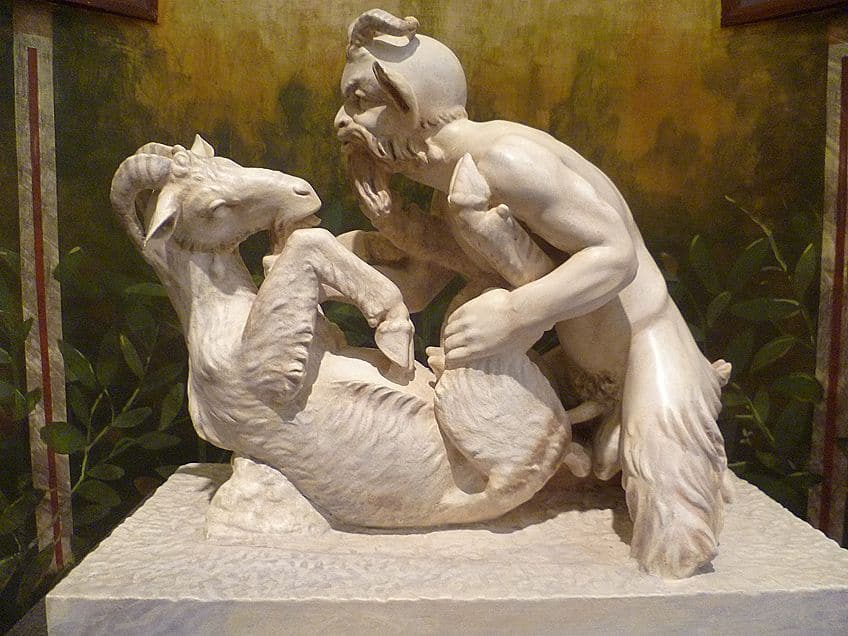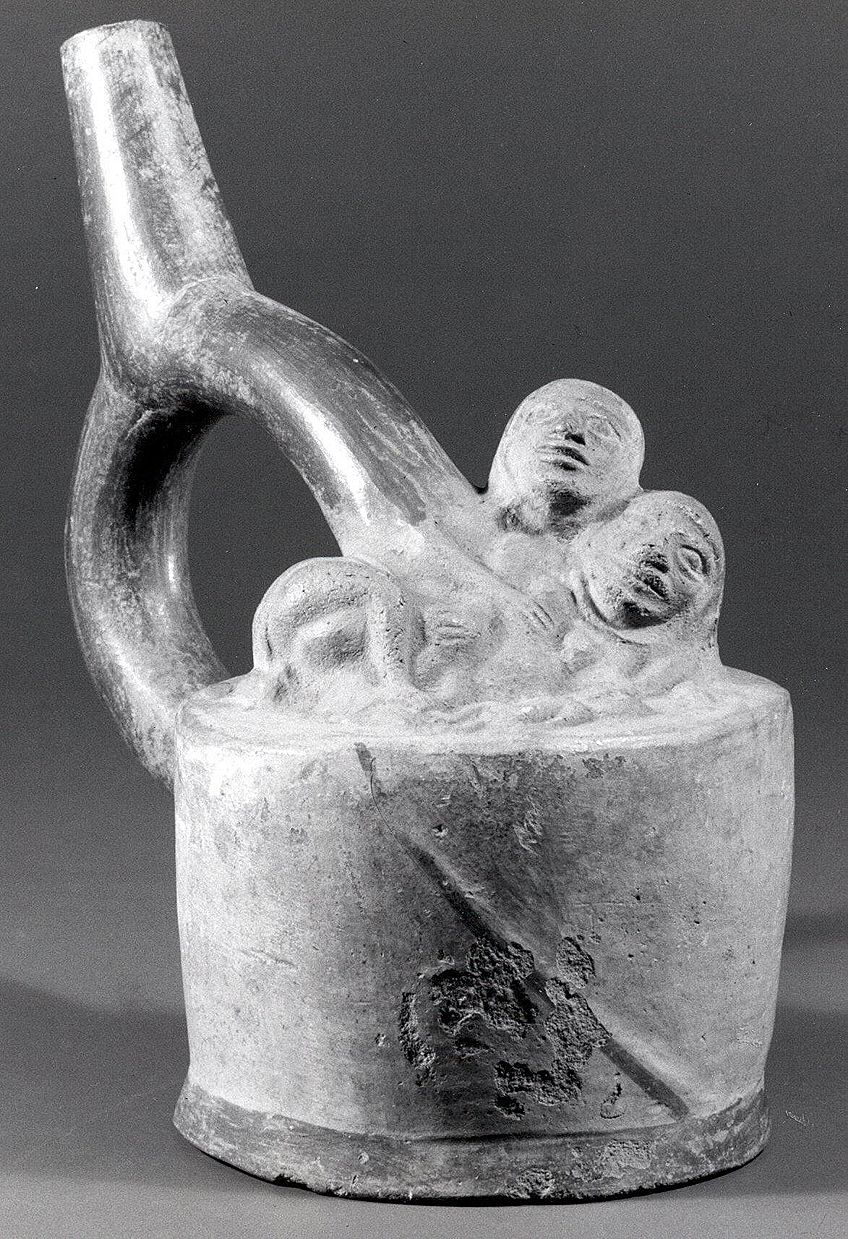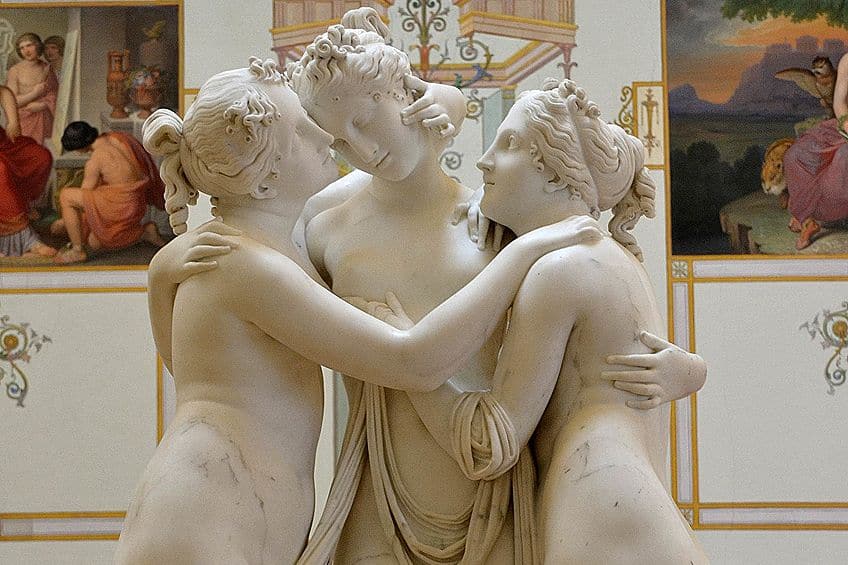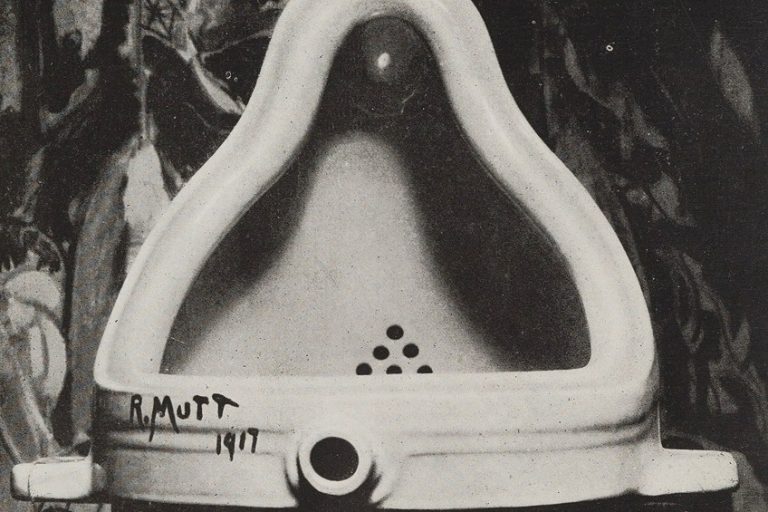Erotic Sculptures – The Historical Art of Nude Statues
Humankind has been depicting sexual art since the dawn of time, and therefore there is no shortage of erotic sculptures in our history. Male and female nude statues portray the idealized version of the human form engaged in the most ancient of pleasures. Sexual statues can impart much about the culture that produced them, so let’s find out more about this ancient genre.
Table of Contents
- 1 The Most Famous Erotic Sculptures
- 1.1 Aphrodite of Knidos (c. 330 BCE) by Praxiteles
- 1.2 Pan Copulating with a Goat (c. 1st Century BCE) by Unknown
- 1.3 Warren Cup (c. 15 CE) by Unknown
- 1.4 Moche Vessel Figures (c. 500 CE) by Unknown
- 1.5 Khajuraho Monuments (c. 1000 CE) by Unknown
- 1.6 Ecstasy of Saint Teresa (1652) by Gian Lorenzo Bernini
- 1.7 The Three Graces (1817) by Antonio Canova
- 1.8 The Kiss (1882) by Auguste Rodin
- 1.9 Eternal Idol (1889) by Auguste Rodin
- 1.10 Hysterical Sexual (2016) by Anish Kapoor
- 2 Frequently Asked Questions
The Most Famous Erotic Sculptures
Throughout history, many societies have produced sexual statues for a wide range of reasons. Erotic sculptures were produced in certain instances as a method of expressing artistic ability and understanding the human physique. In other situations, they were made for religious reasons, such as honoring fertility deities or being utilized in fertility rites. Male and female nude statues have also been used for sexual gratification and to portray sexual behavior for amusement or instructional reasons. They have also been employed in certain cultures to portray idealistic notions of beauty. Here are a few notable examples of Erotic sculptures that continue to titillate, amuse, or anger those who view them.

Aphrodite of Knidos (c. 330 BCE) by Praxiteles
| Artist | Praxiteles (395 – 330 BCE) |
| Date Completed | c. 330 BCE |
| Medium | Marble |
| Location | Roman National Museum, Palazzo Altemps, Rome, Italy |
For the most part, the sculpture of the goddess of love is remarkable because it is one of the earliest female nude statues, a genre that had hitherto been reserved for depictions of males. Earlier Greek art, like pottery, featured naked women, but only concubines or slave girls, not deities. The sculpture was considered one of the most sexual in the ancient world due to its sensuality and elegance, and it was even a tourist destination in antiquity. Pliny reported that some visitors were “overcome with adoration for the statue”, which drove them insane.
Although the sculpture was thought to be particularly provocative, the image itself is not obviously sensual.

The goddess is just frozen in time, having removed her garment and placed it over a kylix (modestly covering her pelvis) to enter a bath. She might have been painted at some point, but it’s difficult to say for sure. The sculpture is the most renowned of Praxiteles’ creations, and possibly one of Classical Greece’s most famous sculptures. Pliny, for example, praised the sculpture as “better than all works, not just of Praxiteles, but also in the entire globe”. From the period of the Romans through the Renaissance, this piece influenced artists for many generations.
Pan Copulating with a Goat (c. 1st Century BCE) by Unknown
| Artist | Unknown |
| Date Completed | c. 1st century BCE |
| Medium | Marble |
| Location | Villa of the Papyri, Herculaneum, Pompeii, Italy |
Pan Copulating with a Goat is an old sculpture that was found in Pompeii. It was one of several sexual statues from an old Roman erotic collection found there. One of Naples’ most cherished pieces of art, this erotic sculpture required parental supervision warnings when it traveled to the United Kingdom a few years ago for the Pompeii Exhibition at the British Museum. The artwork portrays Pan, a wild Greek nature deity, engaging in sexual activity with a nanny goat. Pan is a half-man, half-goat hybrid who is known in Greco-Roman mythology as one of the nature deities noted for his sexual prowess and as a symbol of fertility.

Romans frequently displayed phallic statues in their homes because they thought they may bring good luck, therefore when a sculpture of Pan was shown having sex with a goat, it wasn’t seen as weird or strange because it was symbolic of certain beliefs. Pan was the protector of the countryside, forests and the god of the wild, herdsmen, and flocks in Greek mythology. Pan was referred to as Faunus in Roman mythology and was connected with similar concepts to the Greeks. Pan was seen as a representation of creation, abundance, and the wild frontier in both Greek and Roman mythology.
Warren Cup (c. 15 CE) by Unknown
| Artist | Unknown |
| Date Completed | c. 15 CE |
| Medium | Silver |
| Location | The British Museum, London, United Kingdom |
At Roman dinner parties, this opulent silver cup was often utilized. Originally, the cup had two handles and depicted two pairs of masculine lovers. On one side, two adolescent boys kiss, whereas, on the other, a young man lowers himself onto the lap of his older, bearded boyfriend. A curious slave boy peeps in from behind a closed door. The opulent clothes and musical instruments suggest that these images are situated in a world greatly inspired by Greek culture, which the Romans adored and absorbed in significantly. It reveals much about the Roman attitude toward male-male relationships and erotic sculptures and artwork. Images like these were common in the Roman Empire.
By today’s standards, several of the boys on this cup are underage, yet the Romans accepted partnerships between older and younger males.

Men’s relationships were prevalent in Greco-Roman society, ranging from slaves to emperors, most notably the emperor Hadrian and his Greek lover, Antinous. Such historical paintings remind us now that how civilizations regard sexuality is never static. Sexual activities are frequently shown in Roman art, albeit surviving male-female pictures greatly outnumber same-sex pairings. The current record may be skewed owing to the purposeful destruction of artworks in later times, therefore it cannot be presumed that homoerotic art was uncommon.
Moche Vessel Figures (c. 500 CE) by Unknown
| Artist | Unknown |
| Date Completed | c. 500 CE |
| Medium | Ceramics |
| Location | Moche, Santa Valley, Peru |
From roughly the first through the 8th century CE, the Moche civilization ruled Peru’s arid north coast. Its peoples used the Andes’ waters to develop a sophisticated civilization with a highly hierarchical urban society based on ceremonial pyramid complexes known as huacas. Their material culture included superbly produced fabrics, gold, and semi-precious stone decorative items, wall murals, tattooed mummies, and pottery. The pottery portrays depictions of battle and everyday activities like weaving, as well as at least 500 vessels which bear graphic sexual imagery in the shape of three-dimensional carvings on top of or as an element of the pot. The containers are always functional, having a hollow body to retain liquids and a pouring nozzle, which is sometimes shaped like a phallus. Sodomy, oral sex, and masturbation are the most often depicted; depictions of penile insertion in the vagina are so infrequent that it is essentially non-existent.

The most popular position is anal intercourse, however in the majority of these situations, the partner is heterosexual rather than gay, and their genitalia is meticulously depicted. Another popular picture is of a male skeleton masturbating or being masturbated by a lady. The nature of these sexual sculptures is debatable, with theories ranging from their being instructional pictures teaching contraception, to instances of Moche moralizing or comedy, to depictions of ritual and religious practices. They lack archaeological context for the most part, but a recent thorough archaeological investigation reveals that they were tomb offerings for the elite. This vessel is made up of a fully formed lady masturbating over a male skeleton. The message might be one of a connection between the living and the dead, according to some.
Khajuraho Monuments (c. 1000 CE) by Unknown
| Artist | Unknown |
| Date Completed | c. 1000 CE |
| Medium | Sandstone |
| Location | Madhya Pradesh, India |
Outside and within the Khajuraho temples, there is a diversity of artwork, 10% of which is sexual statues. Small sexual engravings feature on the exterior of the inner wall of certain temples with two layers of brickwork. According to some researchers, these are tantric sexual practices. According to some academics, the sexual arts are part of the Hindu tradition of recognizing kama as a necessary and legitimate component of human existence, and its figurative or explicit presentation is widespread in Hindu temples.
It’s a popular misunderstanding that the carvings on the ancient Khajuraho temple buildings show sex between gods; instead, the kama arts depict a variety of human sexual gestures.

Numerous elements of daily life, mythological tales, as well as symbolic representations of both worldly and spiritual ideals significant to Hindu heritage are all shown in the great majority of works of art. Examples include representations of ladies applying cosmetics, musicians performing, potters working, farmers, and various people going about their everyday lives in the Middle Ages. Even the Kama Sutra scenes express spiritual ideas like moksha when combined with the sculptures that come before and after them.
Ecstasy of Saint Teresa (1652) by Gian Lorenzo Bernini
| Artist | Gian Lorenzo Bernini (1598 – 1680) |
| Date Completed | 1652 |
| Medium | Marble |
| Location | Santa Maria della Vittoria, Rome, Italy |
Gian Lorenzo Bernini’s sculpture was criticized for its emphasis on the materialistic rather than the spiritual from the instant he finished it. This description is still valid today, and contemporary reviewers agree. The majority of Bernini’s contemporaries had favorable opinions of this artwork. Domenico Bernini asserts that Saint Teresa is his father’s greatest artistic achievement. He depicts it as the purest pleasure, with an angel hovering over the saint and shooting a golden arrow of heavenly love straight into her heart. It is believed that The Ecstasy of Saint Teresa was criticized as being extremely physical by the art critics of its time. However, there is just one published source for this opinion, and its creator is unknown.

He says that the sculpture’s flaw is that the pinnacle of ecstasy is depicted as bodily pleasure. “The sculpture is immoral and sexual, which, according to the author of this paper, symbolizes Bernini’s own religiosity and morals”. The work of art displayed Bernini’s ability to produce a dramatic theatrical performance in which he combined holy and profane parts of the theater through the utilization of lighting effects, architectural features, and complex actor-audience connections. Bernini was able to make work that provokes powerful religious experiences and emotions by fusing these components of theater into his art.
The Three Graces (1817) by Antonio Canova
| Artist | Antonio Canova (1757 – 1822) |
| Date Completed | 1817 |
| Medium | Marble |
| Location | Victoria and Albert Museum, London, United Kingdom |
The Three Graces portrays three ladies standing together, their nude bodies interlaced, and their limbs delicately draped. While the sculpture is not overtly sexual in nature, the representation of the women’s bare bodies is perceived as sensuous. The naked human body is regarded as seductive or sexually charged in many cultures, and the Three Graces are no exception. The representation of the women’s bodies in the sculpture, with their delicate curves and silky skin, is intended to be visually pleasing and to elicit sentiments of yearning and sensuality. They are tied together by their clasped hands and a scarf that affords some modesty.
One of the key themes of this masterwork is the oneness of the Graces, which alludes to the three legendary charities who were Zeus’ daughters.

Zeus was the God of sky and thunder in Greek mythology, ruling as King of the Gods of Mount Olympus. The Graces presided over feasts and gatherings to please the gods’ visitors. Many artists have been inspired by and have used the Three Graces as topics. Canova’s skill in molding the stone to accentuate the Graces’ delicate skin is demonstrated in this masterwork, which is carved from white marble. The three goddesses are close together, their heads practically touching and leaning slightly inward, relishing their proximity. Canova’s artistic ability and creativity were legendary, and this piece exemplifies his pioneering style in Neoclassical sculpture.
The Kiss (1882) by Auguste Rodin
| Artist | Auguste Rodin (1840 – 1917) |
| Date Completed | 1882 |
| Medium | Marble |
| Location | Musée Rodin, Paris, France |
Sculptor Auguste Rodin, well known for his work The Thinker, created a number of sexual statues over his career. His sculpture The Kiss which deals with themes of sensuality and erotica is perhaps the most well-known. The Kiss, sculpted in marble in the final year of the 19th century, portrays a scene from Dante’s Inferno and the narrative of two lovers who were condemned for their desire and immorality. Rodin’s decision to leave a space between the lovers’ lips, as though they are stopped in their deed, heightens the piece’s sexual intensity. Rodin caught the instant the lovers kissed, right before Francesca’s husband catches them and murders them both.

Many reviewers were outraged when this work was originally shown because of its sensuality. Nevertheless, the general people adored it, and other duplicates, including several bronze replicas, were commissioned after that. It was presented at the 1893 Columbian Exposition in Chicago, but owing to its contentious nature, it was placed in an internal area that only those who requested it could see. It is reported to have been inspired in part by his model, muse, and helper, Camille Claudel, who went on to become a well-known sculptor in her own capacity. If you would like to see the famous statue for yourself, it is currently on exhibit at the Musée Rodin in Paris, France.
Eternal Idol (1889) by Auguste Rodin
| Artist | Auguste Rodin (1840 – 1917) |
| Date Completed | 1889 |
| Medium | Marble |
| Location | Musée Rodin, Paris, France |
When constructing his sculptures, Rodin emphasized the natural form, and this work is a superb representation of that emphasis. A naked pair of lovers are featured in Eternal Idol. The woman is on her knees, her hands behind her back, the right one caressing her toes. She’s a little higher up on the rock she’s kneeling on. The male kneels in front of her, but at a lower level so that the woman’s head towers above him. His head is nestled between her breasts, his hands folded behind him. Rodin was a great fan of incorporating emotion into his sculptures, and he continues with this one. The man’s face is obscured, but he appears to be kissing the woman’s body, and his face displays pleasure. As she looks down at her lover, the woman in return has a loving expression on her face.
There is a strong sense of closeness between the two. Aside from the emotion, the two subjects’ forms are shown in amazing detail.

Rodin strives to reveal as much as he can, from the woman’s perfectly coiffed hair to the man’s muscular arms and back. Rodin’s artwork was all about multiple interpretations of Eternal Idol. The two subjects seem to be in a romantic relationship based on their expressions. According to experts, Camille Claudel served as the model for another sculpture named Sakuntala, which is said to have served as inspiration for this one. One explanation is the tight bond that Augustine and Camille shared. In the sculpture, the male is smitten with the woman and appears paralyzed in awe. It appears to be a fusion of passion and love, and surrendering to the moment. His hands are in a surrender pose behind his back, and this concept is furthered by the woman’s elevation above the man.
Hysterical Sexual (2016) by Anish Kapoor
| Artist | Anish Kapoor (1954 – Present) |
| Date Completed | 2016 |
| Medium | Fiberglass and gold |
| Location | Multiple Exhibitions |
Anish Kapoor, a British sculptor born in Bombay, recalls the human body in a primordial manner, using curved shapes, inviting recesses, tactile materials, and resonant colors. His work has a sensuous, anthropomorphic character that pervades a wide range of materials, sizes, and colors, and he has frequently referred to sexuality as vital to life and genesis. Among his erotic sculptures, Hysterical Sexual is one of the most overtly provocative. From a distance, it appears to be a cold, abstract ovoid form divided in the middle; nonetheless, it bears an unmistakable likeness to the most intimate portion of the female body, the vulva. Such contrasts abound in this beautiful fiberglass-and-gold artwork.
For example, its smooth, seductive appearance entices the eye yet is hard to the touch, the polar opposite of female genitalia’s yielding flesh. Its mirrored surface welcomes the outside world through reflections, but the core seam resists admission, separating only enough to offer a glimmer of its interior abyss. The use of gold not only associates the vagina with essential value but also highlights its material worth as a valuable commodity. As a result, this work conflates concepts such as abstraction and figuration, inner and exterior, intimacy, and exposure. While Hysterical Sexual might be viewed as an investigation of surface and space, tangible and ethereal, it can also be viewed as a joyful celebration of feminine sexuality. As so, it joins a long history of female genital portrayals and female nude statues in art.
Erotic sculptures have played an important role in the evolution of art, since they have been a part of creative traditions all over the world for centuries. The naked human form has long been cherished as a topic of creative expression in many civilizations, and sexual statues representing the human form in a sensual manner have long been regarded as among the most powerful and expressive works of art. Erotic sculptures may be found in a variety of creative styles, ranging from ancient Greco-Roman art through to the Renaissance, and far beyond to the present day.
Frequently Asked Questions
What Role Do Erotic Sculptures Play in Society?
Throughout the ages, erotic sculptures were frequently constructed as expressions of desire, tributes to the human form, or homage to the love and fertility deities. Erotic sculptures, in addition to their aesthetic appeal, have also played a part in cultural and social critique, since they have frequently been utilized to examine topics of gender, sexuality, and power relations. As such, they have always been a vital element of the creative debate, and they continue to be a significant and influential component of the art world today.
What Was the Purpose of Female Nude Statues in Ancient Times?
Female nude statues were widely used to ornament the residences of the affluent and powerful, since having one was seen as a display of wealth and authority in many civilizations. Female naked sculptures were frequently made in honor of the fertility gods in ancient cultures. In other instances, they were made to be praised as works of art for their aesthetic worth and beauty. In order to respect and adore these deities, these statues were frequently erected in temples or other religious buildings. However, not all erotic sculptures involved female nude statues, and there were many examples of art that just featured men engaged in sexual activities with each other.
Isabella studied at the University of Cape Town in South Africa and graduated with a Bachelor of Arts majoring in English Literature & Language and Psychology. Throughout her undergraduate years, she took Art History as an additional subject and absolutely loved it. Building on from her art history knowledge that began in high school, art has always been a particular area of fascination for her. From learning about artworks previously unknown to her, or sharpening her existing understanding of specific works, the ability to continue learning within this interesting sphere excites her greatly.
Her focal points of interest in art history encompass profiling specific artists and art movements, as it is these areas where she is able to really dig deep into the rich narrative of the art world. Additionally, she particularly enjoys exploring the different artistic styles of the 20th century, as well as the important impact that female artists have had on the development of art history.
Learn more about Isabella Meyer and the Art in Context Team.
Cite this Article
Isabella, Meyer, “Erotic Sculptures – The Historical Art of Nude Statues.” Art in Context. April 5, 2023. URL: https://artincontext.org/erotic-sculptures/
Meyer, I. (2023, 5 April). Erotic Sculptures – The Historical Art of Nude Statues. Art in Context. https://artincontext.org/erotic-sculptures/
Meyer, Isabella. “Erotic Sculptures – The Historical Art of Nude Statues.” Art in Context, April 5, 2023. https://artincontext.org/erotic-sculptures/.











